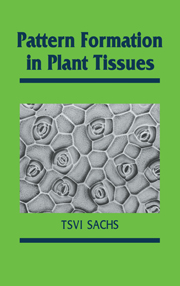Book contents
- Frontmatter
- Contents
- Preface
- 1 Introduction
- 2 Interactions of developing organs
- 3 Hormones as correlative agents
- 4 Callus and tumor development
- 5 The polarization of tissues
- 6 The canalization of vascular differentiation
- 7 Cell lineages
- 8 Stomata as an example of meristemoid development
- 9 Expressions of cellular interactions
- 10 Apical meristems
- 11 The localization of new leaves
- 12 A temporal control of apical differentiation
- 13 Generalizations about tissue patterning
- References
- Author Index
- Subject Index
2 - Interactions of developing organs
Published online by Cambridge University Press: 05 October 2009
- Frontmatter
- Contents
- Preface
- 1 Introduction
- 2 Interactions of developing organs
- 3 Hormones as correlative agents
- 4 Callus and tumor development
- 5 The polarization of tissues
- 6 The canalization of vascular differentiation
- 7 Cell lineages
- 8 Stomata as an example of meristemoid development
- 9 Expressions of cellular interactions
- 10 Apical meristems
- 11 The localization of new leaves
- 12 A temporal control of apical differentiation
- 13 Generalizations about tissue patterning
- References
- Author Index
- Subject Index
Summary
Removing the shoot of a pea seedling results in rapid growth, obvious within two days, of one or more buds (Thimann & Skoog, 1933; Fig. 2.1). The growth of the same buds on intact plants is not noticeable without magnification. This simple experiment is a demonstration in a defined system of a common phenomenon: whenever plants are pruned or eaten by animals their growth is modified so that the missing parts are replaced, leading to a partial or even complete restoration of the original form. This common result must mean that as long as the apical parts of the shoot are present they inhibit, or dominate, the growth of the lateral buds. This relation between the growth of shoots on the same plant has been called ‘apical dominance’ and has been the subject of many studies (Philips, 1975; Rubinstein and Nagao, 1976; Thimann, 1977; Hillman, 1984).
The significance of apical dominance to the control of form is that it is a simple demonstration of a developmental correlation between the parts of a plant (McCallum, 1905). As will be seen below, these macroscopic correlative relations influence not only the development of organs but also the structure of tissues, the main subject of this book.
- Type
- Chapter
- Information
- Pattern Formation in Plant Tissues , pp. 11 - 24Publisher: Cambridge University PressPrint publication year: 1991

